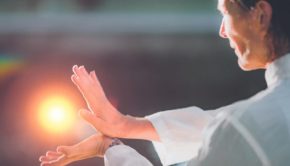Tai Chi And Qigong: Life Force In Motion
The flowing movement of tai chi mirrors the serenity of water, but still waters run deep. This ancient practice of gentle meditative movement is an offshoot of Chinese martial arts that offers a spectrum of surprising benefits, including healthier soft tissues and bones, as well as improved sleeping.
According to Harvard Health Publishing, when practiced consistently, tai chi supports both upper and lower body strength with effects that are akin to resistance training and brisk walking. Tai chi helps to fine-tune neurons of the inner ear and encourages muscle and ligament flexibility, resulting in better balance and fewer falls. The practice is highly adaptable and anyone can benefit, even those that are wheelchair-bound or recovering from surgery.
“It appears effortless, with slow and smooth movements, but there is immense power underneath the tranquility,” says Paul Lam, family physician and director of the Tai Chi for Health Institute, in Sydney, Australia. “Tai chi has been shown by over 500 medical studies to benefit almost all aspects of health, including mobility, immunity and heart and lung function.” Lam also highlights other related benefits, including lower blood pressure, less arthritis pain and stress relief.
A River of Energy
While tai chi is a modified martial art with a focus on form, its close relative, qigong, is a mind-body wellness system that uses breath, simple movement and stillness. Both cultivate qi, or life force, that is believed to permeate all natural existence. The concept of qi, yet to be understood scientifically, is the basis of Traditional Chinese Medicine and the focus of many studies in China and elsewhere.
“It is believed that qi flows throughout and around the body. If we are healthy, the qi will be moving smoothly and abundantly. If we are not healthy, the qi may be stagnant, excessive or deficient,” says qigong instructor and acupuncturist Jeffrey Chand, in British Columbia, Canada.
Robert Chuckrow, a retired physics professor in Ossining, New York, and the author of Tai Chi Dynamics and The Tai Chi Book, explains, “When muscles are tensed, qi is inhibited. Instead, when muscles are relaxed and the body is open and moves naturally, qi is enhanced. Such cultivation of qi is the main component of qigong. Tai chi actually includes qigong.” Chuckrow currently has two students that are 100 years old and notes that seniors greatly appreciate and benefit from these arts once they experience the connection between mind and body.




























